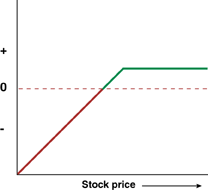OPTIONS
Concerning Your Options
Consider Covered Calls -- And The Caveats
by Kevin Lund
Are there opportunities lurking in this market for you to take advantage of covered calls?
Some strategies work only under certain conditions and, all too often, not for the right reasons. Selling covered calls is a good example. There were a lot of self-proclaimed bull-market "geniuses" in the late 1990s who did nothing more than sell covered calls on technology stocks, pulling in wonderfully ridiculous returns of 20-30% or more per month. Each month brought call sellers (writers) two sources of income: capital appreciation on the stocks they bought, and premiums from the calls they sold on those stocks. But within about one year of the emergence of the bear market in the spring of 2000, it became alarmingly apparent that covered calls spelled disaster for most and did little to protect those "geniuses" from the sharp declines in their stocks as well as their trading accounts.
If this is so, why bring up covered calls now? Whether you think we're in the midst of a "mini-bull" in a larger bear market or the beginning of a new long-term bull market, it's a ripe environment for covered calls. However, there are some new rules to keep in mind.
BUT FIRST, SOME BASICS
Covered calls are nothing more than a way to accelerate your return on investment by selling (writing) a call on a stock you own, giving the buyer of that call the right to buy (call away) your stock at an agreed-upon price (the call's strike price). The safety net for covered call writers is that they are covered because they already own the underlying shares that may need to be delivered to the call buyer. If they didn't own them, and they sold an uncovered (or naked) call, they'd have to go out into the open market and short those shares at higher prices than the strike of the call -- sometimes much higher, thereby incurring a loss on the position. The profit for the covered call writer is the premium received for the call plus any additional amount the stock rises between the purchase price and the strike price.
Taking a closer look at the risk curve of a covered call (Figure 1), it becomes apparent why this strategy lost so many people so much money. Not only is it not as safe as everyone thought; it actually has the same risk curve as a naked put, which is another high-risk strategy that wiped out many trading accounts.

FIGURE 1: RISK CURVE OF A COVERED CALL. By taking a close look, you can see why people lost money using covered calls.
...Continued in the February issue of Technical Analysis of STOCKS & COMMODITIES
Excerpted from an article originally published in the February 2004 issue of Technical Analysis of STOCKS & COMMODITIES magazine. All rights reserved. © Copyright 2004, Technical Analysis, Inc.
Return to February 2004 Contents